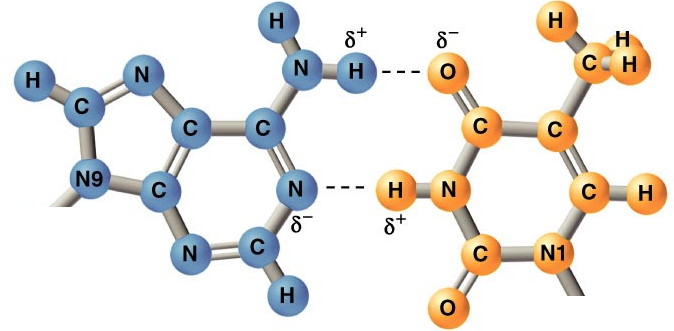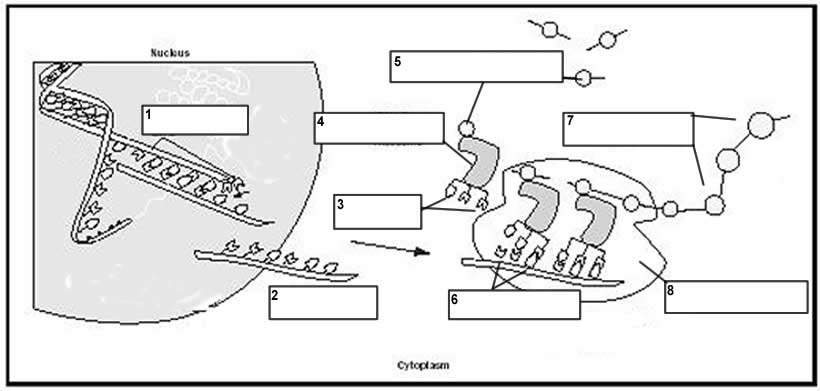05 DNA - The Genetic Material
-
The 3' oxygen of deoxyribose of a DNA nucleotide is linked the ___' oxygen of deoxyribose of the adjacent nucleotide by way of a phosphate group. (The answer is a number.)

This quiz focuses on the discovery and properties of DNA, including key experiments by Miescher, Avery, MacLeod, McCarty, and Griffith that highlight DNA's role as the genetic material.
Quiz Preview
- 2.
Watson and Crick used the X-ray diffraction data of Wilkins and _______. (last name)
Explanation
Watson and Crick used the X-ray diffraction data of Wilkins and Franklin.Rate this question:
- 3.
DNA has a deoxribose - _______ backbone.
Explanation
The DNA molecule consists of two strands that are held together by a backbone. This backbone is made up of alternating deoxyribose sugar molecules and phosphate groups. The phosphate group, which is represented by the chemical formula PO4, forms the "backbone" of the DNA molecule. It provides stability and structure to the DNA molecule, allowing it to maintain its double helix shape. Therefore, the correct answer is phosphate, represented by PO4.Rate this question:
- 4.
The pyrimidines found in DNA are cytosine and _______.
Explanation
The pyrimidines found in DNA are cytosine and thymine. Thymine is one of the four nucleotide bases that make up DNA, along with adenine, guanine, and cytosine. These bases pair up with each other in a specific way, with adenine always pairing with thymine. Thymine plays a crucial role in the structure and function of DNA, as it forms hydrogen bonds with adenine to create the double helix structure of the DNA molecule. Therefore, thymine is a vital component of DNA and is always found alongside cytosine in the DNA molecule.Rate this question:
- 5.
If a frog's DNA consists of 23% adenine, then the percent of guanine is _____%.
Explanation
The percentage of guanine in DNA is always equal to the percentage of cytosine. Since adenine and thymine always pair up in DNA, the total percentage of adenine and thymine is 50%. Therefore, the percentage of guanine and cytosine combined is also 50%. If the percentage of adenine is 23%, then the percentage of guanine is also 23%.Rate this question:
- 6.
Avery, MacLeod, and McCarty showed that ______ of IIIS bacteria was capable of transforming live IIR bacteria in to live IIIS bacteria.
Explanation
Avery, MacLeod, and McCarty showed that DNA (deoxyribonucleic acid) of IIIS bacteria was capable of transforming live IIR bacteria into live IIIS bacteria.Rate this question:
- 7.
On opposite sides of a DNA double helix there are grooves: a larger groove and a smaller groove. The smaller groove is called the _______ groove.
Explanation
The smaller groove on opposite sides of a DNA double helix is called the minor groove. This groove is narrower and less accessible compared to the larger groove. It plays a crucial role in DNA-protein interactions and is involved in the recognition and binding of specific proteins to the DNA molecule. The minor groove provides important structural information and contributes to the overall stability and function of the DNA molecule.Rate this question:
- 8.
Miescher discovered nuclein, a new class of organic molecule. Today we call it nucleic acid. He knew it was not protein because it did not have the element:
Explanation
Miescher discovered nuclein, a new class of organic molecule known today as nucleic acid. He determined that it was not a protein based on the absence of the element sulfur (S) or sulphur. Proteins typically contain sulfur in their amino acid composition, whereas nucleic acids, such as DNA and RNA, do not. Therefore, the absence of sulfur in nuclein indicated that it was a different type of molecule, leading to the discovery of nucleic acids.Rate this question:
- 9.
DNA's two strands run in opposite directions. That is, DNA is _______.
Explanation
DNA's two strands run in opposite directions, meaning that one strand runs in the 5' to 3' direction while the other runs in the 3' to 5' direction. This arrangement is referred to as antiparallel.Rate this question:
- 10.
[The nitrogen base on the right is _______.
Explanation
The nitrogen base on the right is thymine. Thymine is one of the four nitrogenous bases found in DNA. It pairs with adenine through hydrogen bonding, forming a base pair that stabilizes the DNA double helix structure. Thymine is a pyrimidine base, meaning it has a single-ring structure. It is specifically found in DNA and is not present in RNA, where it is replaced by uracil.Rate this question:
- 11.
A DNA double helix 30 base pairs long would be ____Å long. (The answer is a number.)
Explanation
A DNA double helix is composed of two strands that are twisted together. Each base pair in the helix is approximately 3.4 angstroms (Å) long. Therefore, to determine the length of a DNA double helix, we multiply the number of base pairs by 3.4. In this case, since the helix is 30 base pairs long, the length would be 30 * 3.4 = 102 Å.Rate this question:
- 12.
In Griffith's 1928 experiment, when live IIR bacteria and heat-killed IIIS bacteria were injected a mouse:
-
The mouse lived.
-
The IIR bacteria were transformed into IIIS bacteria.
-
DNA was proven to be the genetic material of the bacteria.
-
All of the above.
-
None of the above.
Correct Answer
A. The IIR bacteria were transformed into IIIS bacteria.Explanation
In Griffith's 1928 experiment, the injection of live IIR bacteria and heat-killed IIIS bacteria resulted in the transformation of the IIR bacteria into IIIS bacteria. This transformation was observed in the mouse, indicating that some factor from the heat-killed bacteria had been transferred to the live bacteria, allowing them to gain the ability to cause disease. This result was significant as it suggested the presence of a transforming principle, later identified as DNA, which carries genetic information and can be transferred between bacteria.Rate this question:
-
- 13.
Miescher discovered nuclein, a new class of organic molecule. Today we call it nucleic acid. He knew it was not protein because it had the element:
-
Sulfur
-
Carbon
-
Nitrogen
-
Oxygen
-
Phosphorus
Correct Answer
A. PhosphorusExplanation
Miescher discovered nuclein, which is now known as nucleic acid. He determined that it was not a protein because it contained phosphorus, which is not found in proteins. Proteins are composed of carbon, hydrogen, oxygen, and nitrogen, but the presence of phosphorus in nuclein indicated that it was a different type of organic molecule. This discovery laid the foundation for our understanding of nucleic acids and their role in genetics.Rate this question:
-
Quiz Review Timeline (Updated): Mar 22, 2023 +
Our quizzes are rigorously reviewed, monitored and continuously updated by our expert board to maintain accuracy, relevance, and timeliness.
-
Current Version
-
Mar 22, 2023Quiz Edited by
ProProfs Editorial Team -
May 11, 2009Quiz Created by
Dajatsu
DNA: The Genetic Material Trivia Quiz
Do you know what is a nucleotide? what is the transcription of DNA and RNA? What is the structure of DNA like? Take our online quiz to test yourself and learn trivia as you...
Questions:
81 |
Attempts:
203 |
Last updated:
Feb 20, 2023
|
Test: DNA Structure And Function! Quiz
DNA transports genetic information through its chemical structure and molecular behavior. DNA is a molecule that encompasses the instructions on organism needs to build, live,...
Questions:
17 |
Attempts:
1988 |
Last updated:
Mar 22, 2023
|
Molecular Genetics - DNA
Explore the foundations of molecular genetics in this quiz focused on DNA. Dive into historic experiments by Beadle, Tatum, Hershey, and Chase, understand DNA structure, and grasp...
Questions:
25 |
Attempts:
142 |
Last updated:
May 22, 2024
|
Can You Answer This DNA Trivia Quiz?
Can you answer this DNA trivia? Over the past month, we have extensively covered the use and contents of DNA. Do you think you have been paying enough attention to pass the quiz...
Questions:
5 |
Attempts:
448 |
Last updated:
Mar 19, 2023
|
Biology Chapter 10 Test
The 'Biology Chapter 10 Test' assesses understanding of DNA's unique characteristics, structure, and function. It evaluates knowledge on nucleotides, genetic information...
Questions:
24 |
Attempts:
302 |
Last updated:
Mar 21, 2023
|
DNA Molecule And DNA Fragments Quiz
Can you answer the following DNA questions? Test your knowledge on this science quiz to see how you do and compare your score to others.
Questions:
50 |
Attempts:
192 |
Last updated:
Oct 28, 2024
|
|
 Back to top
Back to top








